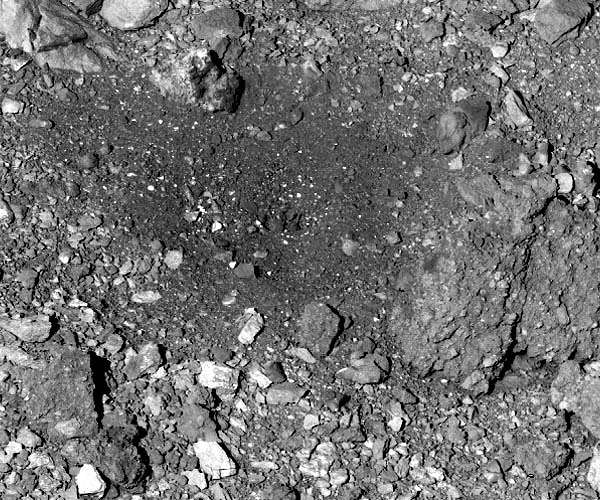
NASA spacecraft observes Asteroid Bennu’s boulder ‘Body Armor’ (Image Credit: Space Daily)
Asteroid Bennu’s boulder-covered surface gives it protection against small meteoroid impacts, according to observations of craters by NASA’s OSIRIS-REx (Origins, Spectral Interpretation, Resource Identification, Security-Regolith Explorer) spacecraft.
“These observations give new insight into how asteroids like Bennu respond to energetic impacts,” said Edward (Beau) Bierhaus of Lockheed Martin Space, Littleton, Colorado, lead author of a paper published in this month’s issue of Nature Geoscience.
Bennu is a “rubble-pile” asteroid, meaning that it formed from the debris of a much larger asteroid that was destroyed by an ancient impact. Fragments from the collision coalesced under their own weak gravity to form Bennu.
The team used unprecedented, high-resolution global data sets to examine craters on Bennu: images from the OSIRIS-REx Camera Suite and surface-height data (topography) derived from the OSIRIS-REx Laser Altimeter, a laser-ranging (lidar) instrument on the spacecraft.
“Measuring craters and their population on Bennu was exceptionally exciting,” said David Trang of the University of Hawaii at Manoa, Honolulu, a co-author of the paper. “At Bennu, we discovered something unique to small and rocky bodies, which expanded our knowledge of impacts.”
Planetary scientists can estimate the age of surfaces by measuring the abundance and sizes of craters. Impact craters accumulate over time, so a surface with many craters is older than a surface with few craters. Also, the size of the crater depends on the size of the impactor, with larger impactors generally making larger craters. Because small meteoroids are far more abundant than large meteoroids, celestial objects like asteroids usually have many more small craters than large ones.
Bennu’s larger craters follow this pattern, with the numbers of craters decreasing as their size increases. However, for craters smaller than about 6.6 to 9.8 feet (around 2 – 3 meters) in diameter, the trend is backwards, with the number of craters decreasing as their size decreases. This indicates something unusual is happening on Bennu’s surface.
The researchers think that Bennu’s profusion of boulders acts as a shield, preventing many small meteoroids from forming craters. Instead, these impacts are more likely to break apart the boulders or chip and fracture them. Also, some impactors that do make it through the boulders make smaller craters than they would if Bennu’s surface was covered in smaller, more uniform particles, like beach sand.
This activity causes the surface of Bennu to change differently than objects with fine-grained or solid surfaces. “The displacement or disruption of an individual or small group of boulders by a small impact is probably one of the most fast-acting processes on a rubble-pile asteroid’s surface. On Bennu, this contributes to making the surface appear to be many times younger than the interior,” said Bierhaus.
Related Links
OSIRIS-REx
Asteroid and Comet Mission News, Science and Technology
|
|
Tweet |
|
|
|
We need your help. The SpaceDaily news network continues to grow but revenues have never been harder to maintain. With the rise of Ad Blockers, and Facebook – our traditional revenue sources via quality network advertising continues to decline. And unlike so many other news sites, we don’t have a paywall – with those annoying usernames and passwords. Our news coverage takes time and effort to publish 365 days a year. If you find our news sites informative and useful then please consider becoming a regular supporter or for now make a one off contribution. |
||
|
SpaceDaily Monthly Supporter $5+ Billed Monthly |
SpaceDaily Contributor $5 Billed Once credit card or paypal |
|
Scientists release first analysis of rocks plucked from speeding asteroid
Chicago IL (SPX) Jun 10, 2022
After a six-year journey, a plucky spacecraft called Hayabusa2 zinged back into Earth’s atmosphere in late 2020 and landed deep in the Australian outback. When researchers from the Japanese space agency JAXA opened it, they found its precious payload sealed and intact: a handful of dirt that Hayabusa2 managed to scoop off the surface of a speeding asteroid.
Scientists have now begun to announce the first results from the analysis of this extraordinary sample. What they found suggests that this ast … read more









